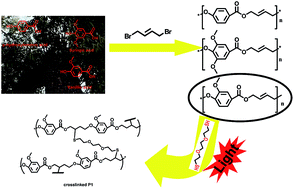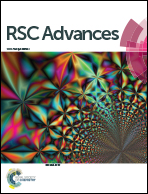Crosslinkable polyesters based on monomers derived from renewable lignin
Abstract
Crosslinked polyesters were successfully prepared using thiol-ene click chemistry. Vanillic acid, syringic acid, and p-hydroxybenzoic acid have similar aromatic structures. They can be derived from a renewable resource, lignin. In this paper, they were used as raw materials for the synthesis of unsaturated thermoplastic polyesters, by polycondensation in solvent. The obtained polyesters were characterized by FTIR and NMR, and their tensile properties were tested. Compared to the other two unsaturated polyesters, the vanillic acid based unsaturated polyester (P1) was found to have the best tensile property. The latter was chosen for the preparation of the crosslinked polyester and further studies were carried out. Differential scanning calorimetry (DSC) revealed an amorphous character of P1, having a Tg of 35.8 °C. Thermogravimetric analysis (TGA) and tensile tests were conducted to study the thermal and mechanical properties of P1 and the crosslinked polyesters. The weight-average molecular weight (Mw) of P1 was found to be 73 000 g mol−1. The unsaturated bonds in the polymers were found to have a special feature, which improved the flexibility of the polyesters on crosslinking. Moreover, both the unsaturated polyesters and the crosslinked polyesters were found to be biodegradable.


 Please wait while we load your content...
Please wait while we load your content...